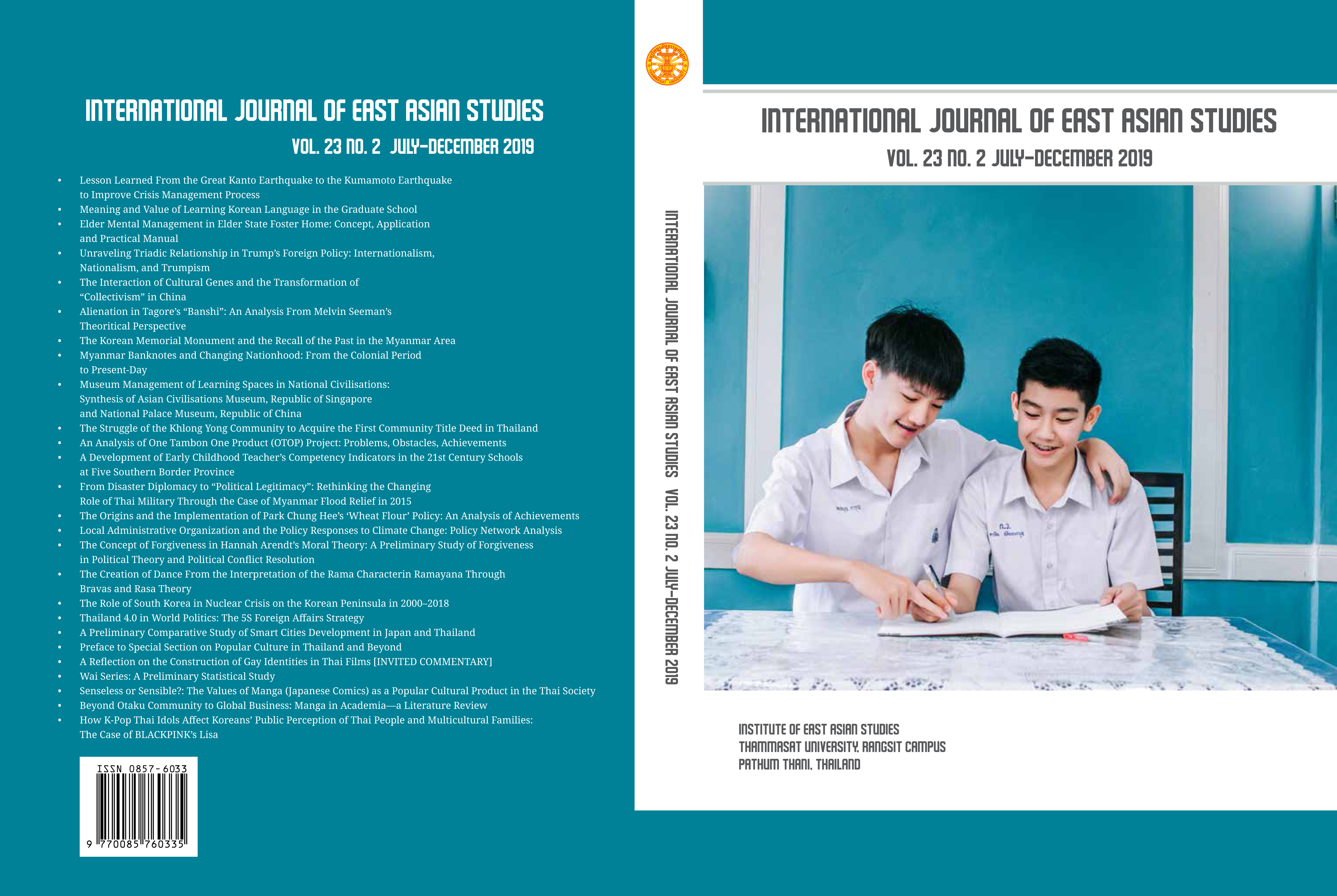Lesson Learned From the Great Kanto Earthquake to the Kumamoto Earthquake to Improve Crisis Management Process
Keywords:
integrated crisis management, natural disaster, crisis response, lesson learned, earthquakeAbstract
Natural Disasters are regarded as crises caused by the act of nature not by human. It is hard to avoid natural disasters, but we can learn from crisis response how to improve crisis management process. Crisis Management process is not complete if we focus only reactive crisis management process. A crisis may recur if an organization unlearns previous crisis experience
Japan is one of the favorite tourist destinations and is also an earthquake-prone country. Great earthquakes in the past destroyed cities and killed many people in Japan, and it provided lesson learned how to improve crisis response. This study applied case studies of earthquakes in Japan from the Great Kanto Earthquake to the Kumamoto Earthquake to illustrate the Framework of Integrated Crisis Management. Research results emphasized on learning process which is one of important parts of Integrated Crisis Management.
Downloads
References
Detailed Analysis of the 2011 Japan Tsunami-Video Footage, Wave Heights and Damage Imagery. (2014, February 4). extremeplanet.me. Retrieved from https://extremeplanet.me/2014/02/04/detailed-imagery-of-the-2011-japan-tsunami.
Epstein, W., Nishimoto, T., Okumura, K., Swan, S. and Yanev, P. (2016, April 29). The Kumamoto Earthquake Investigation: A primary Report.
Hammer, J. (May 2011). The Great Japan Earthquake of 1923: The Powerful quake and ensuring tsunami that struck Yokohama and Tokyo traumatized a nation and unleashed historic consequences. Smithsonian Magazine. Retrieved from http://www.smithsonianmag.com/history/the-great-japan-earthquake-of-1923-1764539.
Krathwohl, D.R. (1998). Methods of educational and social science research; An integrated approach (2nd ed.). New York: Addison Wesley Longman.
Leng, R. (2015). Japan’s Civil Society from Kobe to Tohoku: Impact of policy changes on Government-NGO Relationship and effectiveness of Post-Disaster Relief. Electronic Journal of Contemporary Japanese Studies, 15(1). Retrieved from https://www.japanesestudies.org.uk/ejcjs/vol15/iss1/leng.html.
Maxwell, J.A. (1996). Qualitative research design: An interactive approach. Thousand Oaks,
CA: Sage.
National Oceanic and Atmospheric Administration, U.S. Department of Commerce. (1995, October 14). Great Hanshin-Awaji (Kobe) Earthquake, January 17, 1005. Data.noaa.gov. Retrieved from https://data.noaa.gov/dataset/great-hanshin-awaji-kobe-earthquake-january-17-1995.
National Police Agency of Japan. (2016, February 10). Damage Situation and Police Countermeasure. Retrieved from http://www.npa.go.th/archive/keibi/biki/higaijokyo_e.pdf.
Pailin, M. (2016, August 27). Life on the fault line: major earthquakes overdue and no one in the world is safe, expert says. News.com. Retrieved from http://www.news.com.au/technology/environment/life-on-the-fault-lines-major-earthquakes-overdue-and-n-one-in-the-world-is-safe-expert-says/news-story/0453eac947c8a9485be293364f56ac50.
Pauchant, C.T., and Mitroff, I.I. (1992). Transforming the Crisis-prone Organization: Preventing Individual, Organizational, and Environmental Tragedies. San Francisco: Jossey-Bass.
Preedaananthasuk, C. (2005). Integrated Crisis Management in Business Organization. Mita Business Review, 48(2), 107-128.
Preedaananthasuk, C. (2013). Change Crisis Management viewpoints with Integrated Crisis Management Approach. BEC Journal of Naresuan University, 8(1), 27-38.
Preedaananthasuk, C. (2014). Integrated Crisis Management: What did we learn from Flood Management in Thailand? Universal Journal of Industrial and Business Management, 2(7), 151-155.
Stanford News Service. (1996, January 10). Casualty, damage estimates of great quakes
revised upward. Retrieved from https://web.stanford.edu/dept/news/pr/96/960110greatquake.html.
The Japan Times. (2011, March 17). Kanto area works on energy conservation. Retrieved from http://www.webcitation.org/5y2awhmjE?url=http://search.japantimes.co.jp/cgi-bin/fs20110317a3.html.
The Japan Times. (2015, January 16). The Kobe quake, 20 years on. Retrieved from http://www.japantimes.co.jp/opinion/2015/01/16/editorials/the-kobe-quake-20-years-on/#.WSegIpKGOM8.
The Telegraph. (2017, January 27). The World’s 20 most visited cities-where does London rank? Retrieved from http://www.telegraph.co.uk/travel/galleries/Top-20-most-visited-cities.
Vervaeck, A. and Daniell, J. (2012, March 10). Japan - 366 days after the Quake 19000 lives lost, 1.2 million buildings damaged, $574 billion. Earthquake-Report.com. Retrieved from http://earthquake-report.com/2012/03/10/japan-366-days-after-the-quake-19000-lives-lost-1-2-million-buildings-damaged-574-billion.
Yin, R.K. (2003). Case Study research: Design and methods (3rd ed.). Thousand Oaks, CA: Sage.



